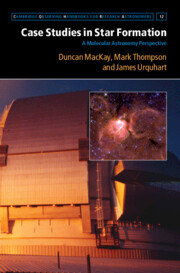Book contents
- Frontmatter
- Dedication
- Contents
- Preface
- List of Acronyms
- Part I Introduction
- Part II Low-Mass Star Formation (LMSF)
- Part III High-Mass Star Formation (HMSF)
- Part IV Ionisation
- 10 Two HII Surveys Using JVLA and ALMA
- 11 G24.78+0.08 in Scutum
- 12 G34.26+0.15 in Aquila
- Part V Photodissociation
- Part VI External Galaxies
- Appendices
- List of Research Journal Abbreviations
- References
- Chemical Index
- Subject Index
11 - G24.78+0.08 in Scutum
from Part IV - Ionisation
Published online by Cambridge University Press: 11 April 2023
- Frontmatter
- Dedication
- Contents
- Preface
- List of Acronyms
- Part I Introduction
- Part II Low-Mass Star Formation (LMSF)
- Part III High-Mass Star Formation (HMSF)
- Part IV Ionisation
- 10 Two HII Surveys Using JVLA and ALMA
- 11 G24.78+0.08 in Scutum
- 12 G34.26+0.15 in Aquila
- Part V Photodissociation
- Part VI External Galaxies
- Appendices
- List of Research Journal Abbreviations
- References
- Chemical Index
- Subject Index
Summary
The G24.78+0.08 source is examined as a multiple core and sub-core complex in which both ultra- and hyper-compact HII locations are identified, along with outflows, accretion disks, and hot cores. Molecular emission lines as well as radio recombination lines (RRLs) and free–free emission offer evidence for thermal, pressure, and dynamical (including infall and rotation) kinematics. Molecular line signatures trace HII/hot core interactions, and also enable estimates of the physical parameters of HMSF accretion disks (such as density, temperature, mass, and radius).
Keywords
- Type
- Chapter
- Information
- Case Studies in Star FormationA Molecular Astronomy Perspective, pp. 176 - 187Publisher: Cambridge University PressPrint publication year: 2023

